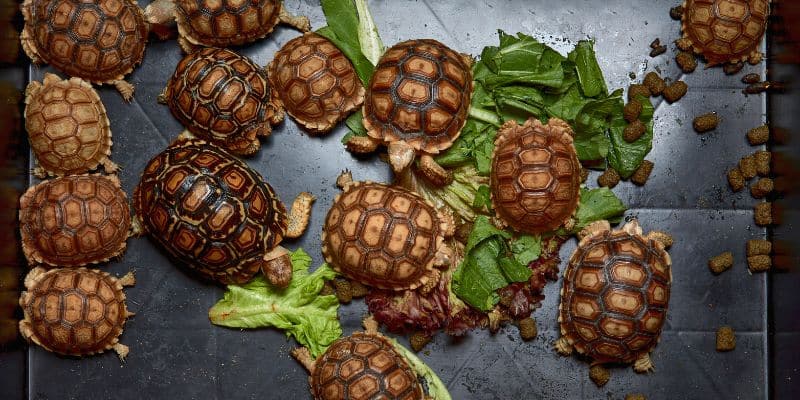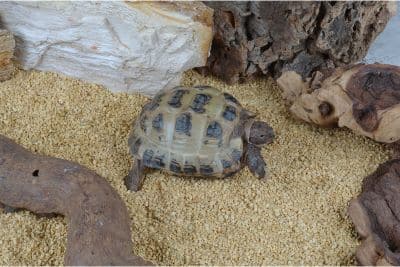Sulcatas (Centrochelys sulcata) can make very rewarding pets, but they require a suitable captive habitat to thrive. And because sulcatas are extremely large tortoises (the third largest species in the world), it can be challenging to set up an enclosure and provide the kind of environmental conditions they need to remain healthy.
But challenging certainly doesn’t mean impossible! If you are dedicated and have sufficient resources, you can set up a fantastic sulcata tortoise habitat. Believe me! I know, and here I’ll explain exactly how to do so.
Understanding Sulcata Tortoises
Sulcatas are large animals, who occasionally reach 30 inches in length or more. Most individuals weigh between 75 and 100 pounds, but very large individuals may exceed 200 pounds (there are unconfirmed reports of a 232-pound captive at the Giza Zoological Gardens).
Of course, sulcatas don’t start life this big – hatchlings only measure about 1.5 to 2 inches in length and weigh about 50 grams.
They primarily feed on grasses and succulents, although they will occasionally eat human refuse, insects, or carrion. Their size provides a great deal of protection from predators, although young individuals are still consumed by a variety of canines, felines, snakes, and birds.
When threatened, sulcatas will withdraw into their shells and guard their face with their heavily armored front legs.
They tend to live very long lives, with occasional individuals reaching 100 years of age or more.
Natural Habitat Overview
Sulcata tortoises are native to a large swath of Africa and a small sliver of the Arabian Peninsula, primarily located south of the Sahara desert. The habitat in this region (called the Sahel) is savannah-like, and characterized by scattered trees, sandy soil, grasses, and low-growing shrubs.
Temperatures in the area are high during the day, and reach 105 degrees Fahrenheit or more. But the nighttime temperatures are much cooler, and occasionally fall below 60 degrees Fahrenheit. Most areas occupied by sulcatas are characterized by two seasons: dry and wet. The tortoises are most active during the wet season.
Sulcatas often dig long underground tunnels, which enable them to escape the midday heat. Some also use their tunnels during periods of dry-weather dormancy (called aestivation).
Essential Elements of a Sulcata Habitat
If you are caring for a captive Sulcata, there are three key elements you’ll need to account for when providing your sulcata with a suitable habitat: adequate space, proper substrate, and an appropriate climate. Allow me to explain how to accomplish each in the section below.
1) Space Requirements
The most challenging aspect of establishing a sulcata habitat is providing enough space.
Hatchling sulcatas are easy to house, as they only require a few square feet of space. A habitat measuring only 1 to 2 feet on each side would be sufficient for several months. However, they’ll quickly outgrow their initial enclosure.

By the time sulcatas reach 4 to 6 inches in length, they’ll require habitats that provide approximately 8 to 10 square feet of space. But within 1 to 3 years, they’ll start approaching adult size and require a very spacious enclosure. Minimally, you’ll want to provide your tortoise with a habitat that is six to seven times as long and wide as the shell length.
Nevertheless, this represents the bare minimum. To ensure your tortoise enjoys a high quality of life, you should provide it with a habitat that provides 100 to 300 square feet of space.
2) Substrate or Bedding
There are a few substrate options for sulcatas. Many keepers use mulch, but mulch doesn’t allow for proper burrow formation.
If you want your tortoise to construct proper burrows, you will need to use soil or a combination of sand and soil. I’ve experimented with different ratios over time and have found a 50:50 mix works best for my sulcatas.
No matter whether you select mulch, soil, or a sand-soil mixture, be sure to provide as thick a layer of substrate as is reasonably possible. When tortoises can’t construct proper tunnels, they like to burrow down into the substrate to regulate their temperature and feel safe.
3) Environmental Conditions
Provide your sulcata with temperatures like those they experience in the wild. Keepers living in areas with a relatively warm climate can rely on the sun to provide the heat their tortoises need, but keepers who live in cooler regions will need to install heat lamps or radiant heat panels.
These devices should be placed at one end of the habitat to allow for the establishment of a thermal gradient, or range of temperatures. The temperatures directly under the heating devices should be at least 100 degrees Fahrenheit, while the temperatures at the opposite end of the enclosure should be in the mid-70s Fahrenheit. Temperatures in the enclosure can be allowed to fall to the mid-60s Fahrenheit at night.
In the unlikely event that you have space to accommodate a sulcata indoors, you will additionally require full-spectrum lighting to provide UVA and UVB rays. This is fundamental for encouraging natural behaviors, and allowing the tortoises to produce sufficient Vitamin D3.
There are essentially two ways to do so: You can install mercury vapor bulbs designed for reptiles or use full-spectrum fluorescent lights. The former type of light also produces heat, thereby eliminating the need for standalone heat lamps, but they cost more than fluorescent lights.
Additionally, the overall habitat should be kept quite dry, but the tortoises should always have access to fresh water and at least one hiding spot with damp substrate inside.
Are You Starving Your Tortoise?
Save 10% on premium tortoise food and supplements from Tortoise Resource Center on Amazon now using code BUYNOWGET10

Sulcata Vitamin & Mineral Topper Supplement
30-Day Supply | 2 oz (56 g)
$24.99

Baby Sulcata Tortoise Superfood Powder
30-Day Supply | 2.5 oz (70.8 g) Bag
$24.99
Indoor vs. Outdoor Habitats
Most sulcata keepers will find that outdoor maintenance is the best option for maintaining adult sulcatas. However, these tortoises can be kept indoors, provided that you have enough space to offer.
There are pros and cons to each approach, which I’ll delve deeper into below.
Pros and Cons of Indoor Habitats
The biggest challenges sulcata keepers face when establishing indoor habitats include the need to provide proper lighting and heat and providing sufficient space. Very few people have 100-square-feet or more to set aside as a tortoise habitat.
On the flip side, indoor sulcata maintenance does provide some advantages.
Most notably, your tortoises won’t be as vulnerable to predators, weather extremes, or nefarious humans. Additionally, most keepers will find it more convenient to tend to indoor enclosures.
Creating an Outdoor Enclosure
There aren’t any commercially manufactured enclosures that are large enough for adult sulcatas, so you’ll have to construct an outdoor enclosure.
Generally, keepers do so by constructing a wooden frame from dimensional lumber. Plywood or plastic panels can then be attached to the frame using weather-resistant hardware. Sulcatas often dig tunnels, so you’ll want to ensure that the enclosure walls penetrate at least 1 to 2 feet below ground level.
Some keepers install wire tops over the enclosure to provide protection from predators.
It is important to set up the habitat in a location that’ll receive plenty of sunlight in the morning, when the tortoises are most active. But it also needs one or more shaded areas, which the tortoises can use to avoid the sun.
Enrichment, Plants, and Décor
Whether you maintain your sulcata tortoises indoors or outdoors, you’ll need to include at least one hiding spot per tortoise. If possible, offer double this many, as this will allow you to keep one of the hides relatively damp while keeping the other one relatively dry.
Aside from this, I recommend including visual barriers and items for the tortoises to explore. This will help provide mental enrichment, as well as encourage more exercise. You can use a variety of things to create these barriers, including driftwood, cinder blocks, large rocks, or plants.
Because your tortoises may attempt to eat the plants included, stick to non-toxic varieties. Spineless cacti are a great option, and they also look nice from an aesthetic point of view.
Maintenance and Cleaning
You’re not finished once you set up your sulcata’s habitat – you must also clean it and provide ongoing maintenance.
Cleaning the habitat is relatively straightforward. You’ll want to inspect the habitat everyday and remove any feces, shed skin or scutes, and uneaten food. Additionally, be sure to wash and refill all water and food dishes.
Once per month or so, you’ll also want to clean the enclosure walls with a tortoise-safe disinfectant, and wash or replace the hides and other enclosure furniture.
There isn’t a great deal of maintenance required for tortoise enclosures, but you will need to repair anything that becomes damaged (such as hinges for the top or latches). You’ll also need to completely replace the substrate periodically (for indoor enclosures – this isn’t really feasible for large outdoor habitats).
If you’re using full-spectrum lights for indoor maintenance, you’ll also need to replace the bulbs on a schedule recommended by the manufacturer – usually once per 6 to 12 months.
Citations and References
- Arbor View Animal Hospital – Sulcatas/African Spurred Tortoises
- Conservation Biology of Freshwater Turtles and Tortoises – African Spurred Tortoise


